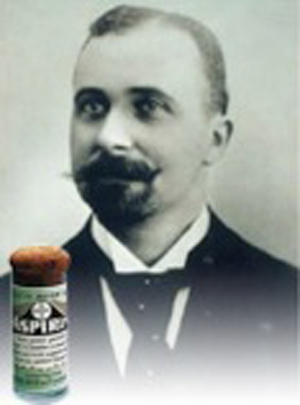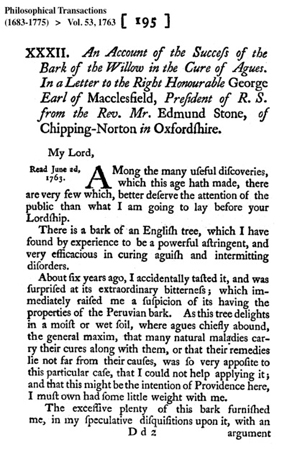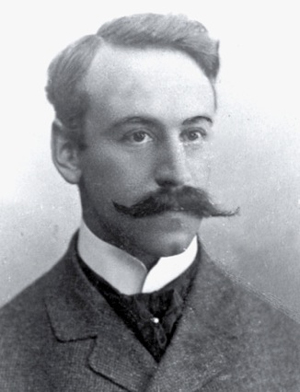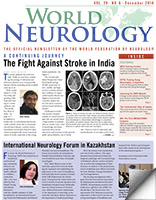
Figure 1. Felix Hoffmann
Edward Stone and aspirin
By JMS Pearce, MD, FRCP
For almost a century, aspirin, one of the most important drugs of the 20th century, was the mainstay of symptomatic analgesia, used universally in the treatment of headaches, arthritis, painful neurological and other maladies. Its introduction is usually credited to Felix Hoffmann’s (1868-1946) synthesis of salicylic acid in 1897. (See Figure 1.) But this is a controversial story. The use of salicylates dates back at least to c. 400 BC when Hippocrates (440-377 B.C.) prescribed the bark and leaves of salix, the willow tree (rich in salicin) to reduce pain and fever. It also was mentioned by Dioscorides (c. 100 A.D.) and later by Pliny the Elder and Galen.
In 1826, Henri Leroux isolated “salicin” from willow bark. However, it had fallen into disuse for centuries until the Reverend Edward Stone rediscovered its efficacy.
The Reverend Edward Stone (The Reverend was formally known as Edward, but was referred to as Edmund by his close friends and family.) was born in Lacey Green, Princes Risborough, Buckinghamshire, on Nov. 5, 17021. He went to Wadham College, Oxford, in 1720. In June 1728, he was ordained to take up the curacy of Charlton-on-Otmoor, Oxfordshire, where he remained until 1730 when he was elected a Fellow of Wadham. In 1745, he moved to Chipping Norton, Oxfordshire, as chaplain at Bruern Abbey.
Dried Willow Bark

Figure 2. Proc Royal Soc 1763, Edmund Stone: Willow bark
On April 25, 1763, Stone wrote to George Parker, second earl of Macclesfield, and president of the Royal Society in a letter read before the Royal Society on June 2, 1763, describing the use of dried willow bark as a remedy for fevers and agues2. (See Figure 2.)
He explained that he had suffered from “aguistic intermitting disorders,” which may have been malaria. In 1757, he had “accidentally” tasted willow bark and noted its extreme bitterness and its resemblance to Peruvian bark (cinchona tree, source of quinine). Arguing from the doctrine of signatures —”that many natural maladies carry their cures along with them, or that their remedies lie not far from their causes,” Stone concluded that the willow tree that “delights in a moist or wet soil” might provide an antidote for agues that chiefly abound in that environment.
He experimented by gathering willow bark from pollarded willows, dried it for more than three months in a bag on the outside of a baker’s oven, pounded and sifted it. He dosed himself, using tiny amounts, but finding that the powder had a salutary effect, increased the dose to two scruples (One scruple equals 1/24 ounce, about 1.25 gm) every four hours. To his delight, “the ague was soon removed.”
Stone gave powdered willow bark over several years to about 50 people complaining of agues or fevers; it was successful in many of them. But, when fevers failed to respond to willow bark, he added quinine, which he found more effective. It’s unclear, however, if any of these patients had malaria. Thus, had Stone accidentally discovered a source of salicylate, the precursor of aspirin.
In January 1764, a fire at Bruern Abbey ended Stone’s chaplaincy there. He died intestate in Chipping Norton on Nov. 26, 1768, and was buried at Horsenden on Dec. 2, 1768.
After Stone’s report to The Royal Society2, willow bark was advised in some herbals, and pharmacists tried to extract salicylic acid from willow bark and meadowsweet (Filipendula ulmaria). Side effects of salicylate were troublesome but were reduced when, in 1853, acetylsalicylic acid or aspirin was made by Hoffman from acetyl chloride and sodium salicylate.
It is usually stated that Hoffmann (See Figure 1.) developed aspirin to help his rheumatic father; but it was not until 1897 that under instruction from Arthur Eichengrün (1867-1949) he synthesized acetylsalicylic acid, which was named aspirin, for the Bayer company. (See figure 3.) Hoffmann’s close associate, Heinrich Dreser (1860-1924), dismissed the market potential of aspirin on the ground that it had an “enfeebling” action on the heart. (“The product has no value.3“) He was preoccupied at the time with the potential of Bayer’s new drug — heroin4.

Figure 3. Arthur Eichengrün
Arthur Eichengrün, whose job it was to discover new products at Bayer, refused to accept Dreser’s rejection of acetylsalicylic acid and pressed for its development5,4. This was later produced commercially by Hoffman and Dreser in 1899, marketed by Bayer as “aspirin,6” whose name derived from Spiraea, then the Latin name for meadowsweet.
However, in 1949, Eichengrün claimed7 that he had instructed Hoffmann to synthesize acetylsalicylic acid, and Hoffmann had done so without understanding the purpose of the work. In 1944, while incarcerated in Theresienstadt concentration camp, Eichengrün had typed a letter (in the Bayer archives8) claiming his objective had been to obtain a salicylate without the adverse effects (gastric irritation, tinnitus) of sodium salicylate. Eichengrün tried aspirin himself, with no ill effects. Its real clinical potential was shown when with Dr. Felix Goldmann, he recruited physicians to secretly test it, they found it was successful in several painful conditions9. Eichengrün did not boast of his prime role in the discovery. Hoffmann lived until 1946, notably without publishing his own account of the discovery of aspirin; he mentioned repeatedly that Dreser had set the drug aside.
Hoffmann’s role was important but was restricted to the synthesis of aspirin: prompted by Eichengrün, who “deserved credit for the invention of aspirin.5”
References:
1. Mann R. ‘Stone, Edward (1702-1768)’, rev. Ralph Mann, Oxford Dictionary of National Biography, Oxford University Press, 2004; online edition, Jan 2008 [http://www.oxforddnb.com/view/article/38014, accessed 27 Sept 2014]
2. Stone E. ‘An account of the success of the bark of the willow in the cure of agues’, Philosophical Transactions Royal Society, 53 (1763), 195-200
3. Dreser H. Pharmakologisches über aspirin (Acetylsalicylsäure). Pflugers Arch 1899; 76: 306-318.
4. Askwith R. How aspirin turned hero. Sunday Times [London]. 1998 Sep 13.
5. Sneader, W. The discovery of aspirin: a reappraisal. BMJ 2000;321: 1591-4.
6. Fairley PA., The conquest of pain (1978) Aspirin Foundation, The amazing story of aspirin (1981) Foster, Alum. Oxon
7. Eichengrün A. 50 Jahre Aspirin. Pharmazie 1949; 4: 582-584.
8. Bayer-Archiv. 271/2.1 Personal data on Eichengrün. Dr A. Eichengrün, Aspirin, KZ Theresienstadt. 1944:2. Cited by Sneader,5.
9. Pearce JMS. The disputed origins of aspirin. In: Fragments of Neurological History. London, Imperial College Press. 2003.
